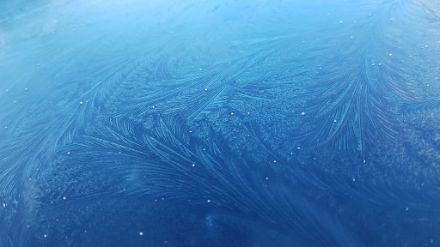Service Navigation
Search
The different forms of ice include:
- Frost/hoar frost and frost/ice flowers
- Rime ice
- Icicles
- Brash ice and hair ice
- Snowflakes
- Sleet and hailstones
- Drift ice and pack ice
- Icebergs
- Shelf ice or ice shelf
- Glaciers and ice caps
So, ice comes in many different forms and can transform easily from one into another. It can be short-lived, or it can last a long time.

How ice forms
In normal circumstances, the freezing point of water is zero degrees Celsius. But for ice crystals to form, ice nucleating particles are needed (e.g. dust particles). The more similar the surface structure of a material is to ice, the more suitable it is as a nucleating particle.
Highly purified water can be cooled to below -30 degrees in a laboratory before it freezes. When liquid water has a temperature of below zero degrees, this is known as “supercooled water”. The freezing point of water can be lowered by adding salt (or sugar), a fact that is exploited by the winter road maintenance services to prevent or delay ice formation on roads.
In summary, ice can form in the presence of sufficient moisture, ice nucleating particles and sub-zero temperatures. Because the density of ice is lower than that of liquid water (known as the water density anomaly), ice floats on the surface of water. Only about 10% of the ice volume protrudes from the water, leaving the remaining 90% of the ice volume below the water’s surface.

The formation of different ice forms
Below, the formation processes of the most common ice forms are briefly described.
- Hoar frost/ice flowers: Hoar frost forms when water vapour undergoes resublimation, transforming directly from the gaseous state to the crystalline state. Ice flowers are a specific type of hoar frost.
- Rime ice: When fog droplets rapidly freeze on objects at temperatures between -2 and -10 degrees, rime ice forms. Stronger winds encourage the formation of rime ice.
- Icicles: Icicles form as water droplets freeze. For example, during the day, snow on the roof can melt and the water drips slowly from the edge to the ground. When temperatures fall at night, the water cools and can freeze. If water continues to run down from the roof, it will meet the already frozen droplets and freeze as well. An icicle builds up slowly, layer by layer, or drop by drop, always growing from top to bottom.
- Brash ice: When water at the upper end of soil pores freezes, expands and protrudes, making it seem like ice needles are growing from the ground.
- Hair ice: Hair ice consists of ice needles that form on decayed and moist deadwood.
- Snowflakes: Very fine water droplets slowly accumulate on ice nucleating particles (e.g. dust particles) and freeze. Snow comes in many different forms.
- Sleet and hailstones: Hail forms when water droplets in thunderclouds are lifted to higher and colder air layers by updrafts, where they freeze into ice grains.
- Drift ice and pack ice: Pack ice is an area of sea ice that is not connected to the land and consists of smaller pieces of ice frozen together. The smaller ice pieces are also called drift ice or floating ice. Ice floes are the largest and most common form of drift ice. They can be metres or even several kilometres wide and often collide with other ice floes. When currents and winds bring drift ice or ice masses together and freeze them into a single large mass, pack ice is formed.
- Icebergs: Ice masses that break off from glaciers (in a process known as glacier calving) and drift freely in open (saline) waters are called icebergs. The size and shape of icebergs can vary greatly. Icebergs are composed of freshwater with air pockets.
- Shelf ice or ice shelf: When ice from glaciers or ice sheets reaches the coast, it floats on the sea above a specific water level while remaining connected to the glaciers on the mainland. When ice that is floating on the sea has a height of at least two meters above sea level, it is called an ice shelf. Shelf ice is usually between 200 and 1,000 metres thick. Icebergs regularly break off from the outer edges.
- Glaciers and ice caps: Glaciers and ice sheets are ice masses that extend over large areas. Ice sheets occur on a continental scale.

Benefits and challenges
Ice can serve a variety of purposes, such as freezing food, protecting plants against frost (in german) in agriculture, making winter sports possible, or facilitating transportation in winter.
But ice can also be a nuisance, or even hazardous:
- On roads as black ice or snowdrifts
- In shipping in the form of icebergs or pack ice
- On aircraft as icing
- In the construction industry, e.g. due to ice or snow loads, frozen ground or pipes
- When having to scrape ice off the car windscreen in the morning
Last but not least, ice can enchant us with delicate, sometimes fleeting phenomena such as hair ice and frost, or as man-made ice sculptures.
